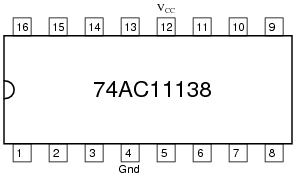IC fabrication and packaging
Question 1:
What does it mean if an integrated circuit comes in DIP form? What does the acronym "DIP" mean?
Challenge question: what is the standard spacing between pins on a DIP IC?
Notes:
Explain to your students that DIP packaging is not used for integrated circuits with more than 48 or so pins, and then ask them why that might be.
Question 2:
Where are the power supply pins most commonly located for integrated circuits in the standard "DIP" form? Some manufacturers of high-speed digital ICs are now relocating power supply pins to the middle of the package, like this:

|
|
Explain the rationale for this non-traditional pin assignment.
Centered power supply pins on modern high-speed DIPs exhibit less parasitic inductance than corner-located pins.
Follow-up question: what is the best way to determine pin assignments on any given integrated circuit?
Notes:
Let your students know that even some of the older integrated circuits had "weird" power supply pin locations, so they cannot assume corner-pins for every older DIP they see! An example of this is the 2102L static RAM, or the 4049 CMOS hex inverting buffer.
Even stranger is DIP chips with multiple +V and GND pins. Good examples of this include the 74AC11004 and the 74AUC16373.
Question 3:
Find one or two real integrated circuits and bring them with you to class discussion. Identify as much information as you can about your ICs prior to discussion:
- �
- Manufacturer
- �
- Part number
- �
- Function
- �
- Datasheet
- �
- Date of manufacture
Notes:
The purpose of this question is to get students to kinesthetically interact with the subject matter. It may seem silly to have students engage in a ßhow and tell" exercise, but I have found that activities such as this greatly help some students. For those learners who are kinesthetic in nature, it is a great help to actually touch real components while they're learning about their function. Of course, this question also provides an excellent opportunity for them to practice interpreting component markings, use a multimeter, access datasheets, etc.
